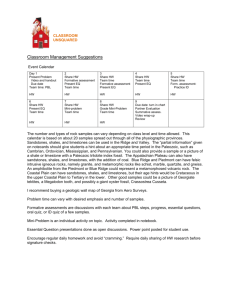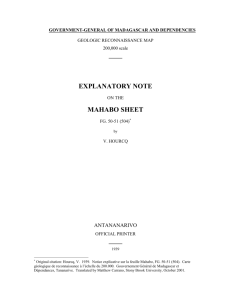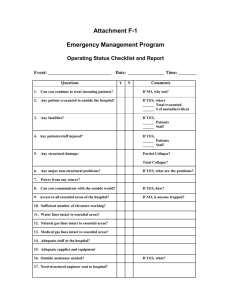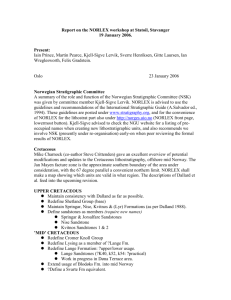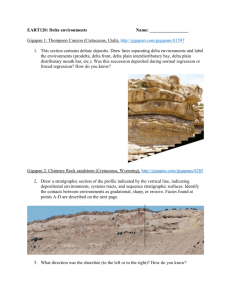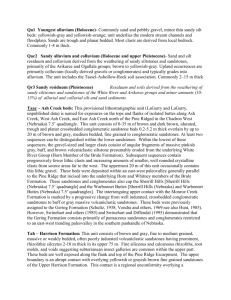Les terrains postérieurs au Crétacé moyen de la région de Majunga
advertisement
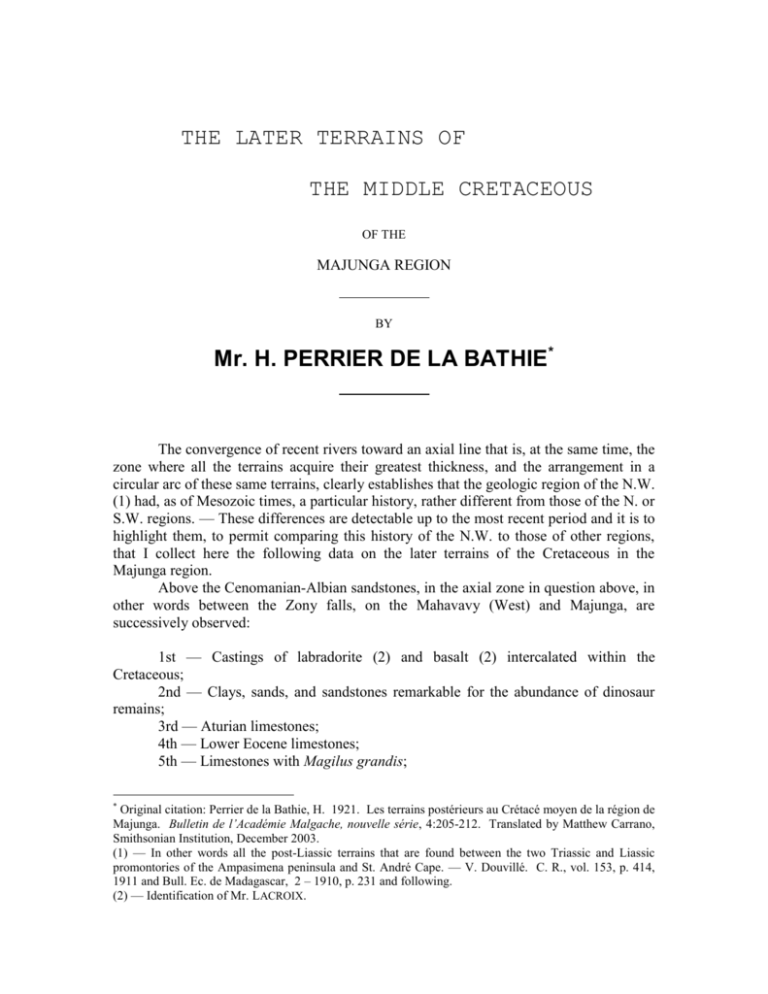
THE LATER TERRAINS OF THE MIDDLE CRETACEOUS OF THE MAJUNGA REGION BY Mr. H. PERRIER DE LA BATHIE* The convergence of recent rivers toward an axial line that is, at the same time, the zone where all the terrains acquire their greatest thickness, and the arrangement in a circular arc of these same terrains, clearly establishes that the geologic region of the N.W. (1) had, as of Mesozoic times, a particular history, rather different from those of the N. or S.W. regions. — These differences are detectable up to the most recent period and it is to highlight them, to permit comparing this history of the N.W. to those of other regions, that I collect here the following data on the later terrains of the Cretaceous in the Majunga region. Above the Cenomanian-Albian sandstones, in the axial zone in question above, in other words between the Zony falls, on the Mahavavy (West) and Majunga, are successively observed: 1st — Castings of labradorite (2) and basalt (2) intercalated within the Cretaceous; 2nd — Clays, sands, and sandstones remarkable for the abundance of dinosaur remains; 3rd — Aturian limestones; 4th — Lower Eocene limestones; 5th — Limestones with Magilus grandis; * Original citation: Perrier de la Bathie, H. 1921. Les terrains postérieurs au Crétacé moyen de la région de Majunga. Bulletin de l’Académie Malgache, nouvelle série, 4:205-212. Translated by Matthew Carrano, Smithsonian Institution, December 2003. (1) — In other words all the post-Liassic terrains that are found between the two Triassic and Liassic promontories of the Ampasimena peninsula and St. André Cape. — V. Douvillé. C. R., vol. 153, p. 414, 1911 and Bull. Ec. de Madagascar, 2 – 1910, p. 231 and following. (2) — Identification of Mr. LACROIX. 206 LATER TERRAINS OF THE MIDDLE CRETACEOUS OF THE MAJUNGA REGION 6th — Sands and alluvium with quartz pebbles; 7th — Finally covering nearly all these periods, traces of a Quaternary transgression. To study these different levels, I will proceed from the most recent to the most ancient. QUATERNARY TRANSGRESSION. — This transgression left traces up to an altitude of 30 m and at a distance of 70 km from the current sea. Some of the fossil localities observed are situated in the environs of Ambolimoty, on the southern and S.E. borders of the Marovoay plain, and others on the Mahavavy, between Lake Kinkony and the mouth of this river. In the localities in the environs of Ambolimoty (Amboboka, Anjobajoba, Ambohimena) are only found shells of two species of Ostrea, of which one belongs to the O. cucullata (1) group and the other cannot yet be identified. At Amboboka, 4 km east of Ambolimoty, at around 25 m altitude, these oysters are piled up in small hills that I first took for “cooking debris,” but that a deeper examination showed me to be only simple remains of blocks of sandstone covered with oysters and disaggregated in place. At Ambohimena and Madirokely these shells are only seen at the level of the plain, in other words at around 10 m above low tides. At Anjobajoba, they are observed again up to 22 m altitude, and they are fixed there, some on the quartz pebbles in the ancient alluvium, others on the fossils (wood and bones) of the dinosaur clays and sandstones and even sometimes on fragments of basalt. Those from the Mahavavy show a much more varied marine fauna, much richer in species, according to Mr. PETIT (2), nearly all still living on the reefs of the western coast, below the low-tide level. These shells are found in abundance throughout the Mahavavy delta up to an altitude of 10 m, but the most remarkable locality, both for its location and its richness, is situated at around 500 m downstream from Antaboka (upstream from Ambato) on the right bank of the river. One sees there, at around 30 m altitude, 25 km from the current stream banks, a veritable mass of shells and corals, nearly 5 m thick, are extended over more than a hectare of surface (3) and rest on the Aturian limestones. But the fossils are not the only traces that were left by the Quaternary transgression in the Majunga region. The alluvial plains of the Mahajamba-Sofia, those of Marovoay and Mahabo on the Betsiboka, those of the environs of Kinkony (4) on the Mahavavy, are bordered on their periphery by a salt zone, rich in halophytic plants, that (1) — Identification and indications of Mr. Boule. “These oysters belong to the Ostrea cucullata Bon. group, currently living in the Indian Ocean — This is neither O. cucullata proper, nor O. vivrefacta San., which seems to be perhaps paludal and is found in Madagascar” (Mr. Boule in litt.). (2) Mr. Petit, in charge of the Muséum mission, who studied for more than a year the marine fauna of the coasts of Madagascar, agreed to examine these fossils and to accept having made the study upon his return to the Muséum. (3) Covered in woods and rather dense undergrowth. (4) Lake Kinkony itself, in spite of its little depth (4 m in the middle) is certainly a remnant of a Quaternary bay. — This is certainly an alluvial lake, in other words a depression barred by the alluviums of a river; but the depression itself, today in the process of very advanced filling, could not have been formed with the current base level. LATER TERRAINS OF THE MIDDLE CRETACEOUS OF THE MAJUNGA REGION 207 indicates very clearly the shores of this ancient sea and that allowed me to outline the limits on the attached map. As is seen these limits outline three very deep bays, in a narrow throat with the crossing of the Eocene and Aturian limestones, widened in contrast on the dinosaur clays, clays that are only decalcified marls and whose outcroppings occupy entirely a topographic depression. Such a model proves obviously that these three bays, like the current estuaries of the Mahajamba, the Betsiboka, and the Mahavavy, are submerged Pliocene valleys, which could only be hollowed when the base level was much lower than it is currently, in other words during a previous regression. ALLUVIUMS WITH QUARTZ PEBBLES. — On the entire western slope from altitude 800 to altitude 50 near the sea are observed the scraps more or less extended of alluvial sediments, generally gold-bearing, with quartz pebbles, generally accompanying chalcedonies and fragments of silicified wood, resting on all the other terrains, except on the remains of the Quaternary transgression. These sediments are probably of very diverse ages. They are often, above all on the wide Triassic-Liassic sandstones, which contain also entirely similar pebbles and silicified wood, very difficult to distinguish from the alluviums or eluviums coming from the subjacent terrains. Also, to rest on a surer terrain, I will deal here only with those of these sediments situated near the sea, relatively well dated, since they rest on the upper terrains of limestones with Magilus grandis and the Quaternary oysters are fixed on their pebbles. These alluviums, very well represented in the environs of Majunga, are always very lateritic, which seems to prohibit the hope of finding fossils one day. They rest either concordantly on one of the sands much later than the limestones with Magilus grandis (see section of Makamba Island), or discordantly (on an erosion surface) on more ancient terrains. These are coarse sands, often in intersected beds, of clearly fluviatile origin. The pebble beds are frequent there. These pebbles, of a rather uniform size approaching that of a fist, are uniquely constituted by quartz, which is very often quartz from quartzite, sometimes quartz with magnetite, with traces of very clear beds. They are well-rolled and often broken, under the action, I think, of heat and nighttime re-cooling. The chalcedonies (of sedimentary origin) are rather frequent there. The fragments of silicified wood sometimes exist there, but I think that they are here, as well as the pebbles, of simple hard materials taken from other terrains. Finally the gold, very flat, very light, very fine that one always observes there, is disseminated throughout the mass in negligible quantity, never exceeding, in the places most enriched by eluvium, the content of 10 to 31 centigrams per ton. These deposits can reach a total thickness of 15 meters. They lie habitually at a higher altitude as one moves away from the sea and approaches the central plateau, but I have never observed them, in place, at less than 50 meters altitude; this minimum altitude simply indicates, in my opinion, the soil thickness removed by erosion since the deposition of the alluviums. The terrains that they cover in perfect concordance, without erosion surface indicating a discontinuity in sedimentation, are at Makamba Island (see the island section): 15 meters of fine, siliceous, well-bedded sands, a clearly terrestrial or quiet water formation, surmounting 16 meters of marls and sands, with some Ostrea debris at the summit, a more clearly littoral deposit resting moreover (at 20 m altitude) on clearly marine marls with Magilus grandis and other corals. 208 LATER TERRAINS OF THE MIDDLE CRETACEOUS OF THE MAJUNGA REGION The quartz and quartzite pebbles that are seen in abundance in these deposits, like the gold which they contain, can only come from the central massif or the coarse sands at the edges of this massif. Still currently the erosion and lateritization, whose action is inseparable here, leave only the very similar quartz pebbles remaining of the metamorphic rocks; but these pebbles, as a result of the lack of slope, can no longer cross the peripheral depression (1) that borders the central massif and which is situated 150 km from the coasts, at around 80 meters altitude. For these pebbles to have been brought formerly up to the site of the current sea, a much stronger slope was needed, and as a result, since the rivers then still had a torrential run and rolled the pebbles to altitude 50, a base level placed infinitely lower. It is, as a result, I think, legitimate to conclude that these alluviums before the hollowing of the Pliocene valleys indicate, like the valleys at the end of the Tertiary, a considerable regression relative to the current banks, during the course of which Madagascar and Africa could well have been in connection (2). MAGILUS GRANDIS BEDS. — Below the terrestrial and fluviatile deposits that have just been questioned, one observes at Majunga, Makamba Island, and Cape Tanjona (see sections of Makamba Island and Cape Tanjona), some more or less sandy marls or limestones, about twenty meters in thickness (22 meters at Makamba, 20 meters at Cape Tanjona), rather fossiliferous, whose most frequent and characteristic fossils (1) for the region are Magilus grandis Tornq. and Schizaster hova Tornq. These beds are sometimes rather rich in bones (Makamba Island, Cape Tanjona), and their methodical excavation will permit without doubt some interesting discoveries. The base of these Magilus grandis beds is, at Tanjona, at 35 meters altitude; at 7 altitude at Makamba; and at sea level at Majunga. These deposits are coarser to the south (Tanjona) than in the north (Majunga) where they are clearly limestones. The geographic distribution of their outcrops shows that they are strictly localized in the axial part of the region. Finally, they rest perfectly concordantly on sandstones with calcareous cement and marly intercalations that are seen at Cape Tanjona over 35 meters of thickness. What is the thickness of these lower sandstones? Do they all rest on the limestones that are seen to outcrop east of Majunga, at Amparangidro, between the nummulitic beds and those with Magilus? The absence of topographic relief and natural sections, and above all the lateritic alluvial debris that covers nearly all the soil, does not permit seeing with certainty the relationships of these diverse beds, but I think nevertheless that these sandstones of Tanjona and these limestones of Amparangidro are well intercalated between the Magilus beds and those which will be questioned. NUMMULITIC. — The limestones of Amparangidro — in which are only seen indeterminable shell debris, have a minimum thickness of 20 meters, as much as permits judging the state of ruin of their outcrops. The rest on very compact siliceous rocks at Belobaka and Mangatsoa, true grindings that contain the remains of numerous nummulites (1) and form a very distinct bed that I observed only at Belobaka, but also (1) — In other words the depression that G AUTIER and myself have called the Triassic valley. (2) — Mr. JOLEAUD (Bull. Soc. Géo. Fr. XX, pp. 13-26 — (1920) arrives, by entirely different means, to an analogous conclusion, but more precise — and dates the passage of hippopotamuses to Madagascar to the Pontian. (1) — Studies by TORNQUIST, V. PAUL LEMOINE. Géologie du N. de Madagascar, p. 249. LATER TERRAINS OF THE MIDDLE CRETACEOUS OF THE MAJUNGA REGION 209 much farther north, on the Antshalava and Mariarano, or to the south, at Ambato, on the Mahavavy and at Bedango, east of Soalala. These grindings, which constitute scattered blocks amidst the decalcified clay, very sterile sandstones, have without doubt their origin in decalcified limestones, or silica dissolved in the upper beds, during their transformation into lateritic clay, is concentrated. At Ambato, on the Mahavavy, grindings and clay rest on the chalky limestones, which belong hardly to the top of the hydrostatic bed, and which are probably evidence of what were the beds of this layer, before their transformation. The nummulitic limestones (2) that are found immediately below the grindings form a rather continuous band that can be followed fairly easily (although it often is hidden under the Pliocene alluviums) from Mahajamba Bay to Baly Bay. I ignore their exact thickness, because they generally appear only in the state of scattered blocks amidst the decalcified clays, which without doubt come from their attack by rain water. According to the width of the outcrops of these limestones, which like all other sediments of the region plunge very slightly toward the sea or more exactly toward the N.W., I estimate their minimum thickness at about fifty meters. I believed for a long time in the existence of a fault, as in the southern region, between the Aturian and Eocene limestones. I sought there vainly for evident proof, and I believe rather now in the normal superposition of the two terrains. The topographic depression that is seen nearly always on their line of contact is only, indeed, a very probable consequence of the greater solubility of the nummulitic limestones, less clayey than those of the Aturian. ATURIAN LIMESTONES. — These limestones constitute large, rather flat plateaus with some small basins of absorption, analogous to the Jurassic limestone plateaus, rather sterile, and lacking water. Their highest beds (those on which rest the nummulitic if the two terrains are not separated by faults) are clayey limestones containing only a single fossil, a small urchin of the genus Micraster, very abundant and which characterizes clearly this level, in the entire region at least. Below these urchin beds, perhaps a dozen meters in thickness, is seen 35 to 45 m of limestones, with rare fossils or entirely lacking them, resting on 3 to 4 meters of marls always very fossiliferous. It is this last bed from which come all the fossils noted at Mevarano by DEPERET and at Mahanovo by BOULE and St. MEUNIER (1) like those that I have recovered myself, in several localities situated between the Mahajamba and the (2) — According to Mr. DOUVILLE (in litt.) who had the kindness to examine these fossils, these beds are Lower Eocene, with species having affinities with those of Egypt. (1) See the list of these fossils in P. LEMOINE, Études Géologiques N. Madagascar, p. 231. Mr. LEMOINE cites as Aturian localities the base of the volcanic piinnacle of Tsitondraina (which appears contestable to him besides), where there is in reality only Jurassic and Lower Cretaceous, and Besava, where, if it is truly Besava to the S.W. of Madirovalo, there is only middle Cretaceous or basalts. This last indication comes from Baron, whose localities are not always exact. Thus, it is still according to the fossils recovered by him, which Newton refers to the Bathonian limestones, on which rested the Aturian of Ambohitrombikely, near Majunga, or however nothing similar is seen. There are three Ambohitrombikely in the region: one near Majunga, where only the Aturian is seen; another near Ambato, on the Upper Jurassic; the 3rd is on the Bathonian, near Ankoala. BARON must have passed the first and the last, where existed formerly two small Hova posts, and it is doubtless to a simple confusion of labels that we owe the strange reappearance of the Bathonian in the immediate environs of Majunga. 210 LATER TERRAINS OF THE MIDDLE CRETACEOUS OF THE MAJUNGA REGION Betsiboka. The most frequent, the most characteristic, for the region, are Gryphaea vesicularis and Alectryonia ungulata. The Mevarano locality was totally destroyed following the exploitation of a lime kiln. This very restricted limestone locality was indeed constituted only by the covering of a pyramid of erosion, a flat-topped outlier, analogous to that which is seen still several kilometers more to the east, whose base of sandstone and friable sands were eroded by the Betsiboka and whose limestone cap slipped down to the edges of the river, around 130 m lower than its normal position. At its S.E. limit the Aturian plateau, like all the sedimentary plateaus (2) of the region, indeed constitutes a long “coast”, very cut out by erosion, from 130 to 180 m high formed by a base of clays, sandstone, and sands, crowned by the projection of the Aturian limestone, which can be followed from the Mahajamba to the Mahavavy and even beyond, on the right bank of the Kinkony. The base of the Aturian limestones is placed at 150 m altitude, near Miadana, which is situated 50 km from Amboanio, where this same base disappears under the sea, which gives them a plunge of 3 0/00. The Ostrea marls which form this base rest on clear-colored marls or marly sands, without fossils 2-3 m of thickness, that pass insensibly to terrestrial or lagoonal sediments of the lower stage. At this level, there is no trace of basal conglomerate and the transgression is obviously made by an insensible fact, without interruption in the sedimentation. DINOSAUR CLAYS, SANDSTONES, AND SANDS. — I divide this much thicker series which precedes them into three substages: 1st, Mevarano sands and fine sandstones; 2nd, thick Marovoay sandstone; 3rd, Ankazomihaboka sandstone and marls. The Mevarano sands and fine sandstones have about 130 m of thickness and are very well represented along the “coast” formed by the S.E. limits of the Aturian. Along the entire summit, these are initially sands or soft sandstones, fine, white, well bedded, then follow sandstones in very thick beds, sometimes more or less thick, often containing small rolled chalcedonies with numerous clay intercalations. These clays are generally brownish and the sandstones and sands are clear in color, often a bright white in the newly eroded parts. In the beds, where less active erosion has left these sediments the time to lateritize, they are in contrast more or less colored and redder as they get closer to the surface. The dinosaur bones (1) recovered from the environs of Miadano and Mevarano by BASTARD and DECORSE and studied by DEPERET (2) and THEVENIN (3), were recovered in the beds at the base of this substage. They are generally abundant at the base of the entire Mahazamba projection at the Mahavavy, but they are nearly always very poorly preserved. The highest level where I observed these bones is at least 40 m below the Aturian marls. In the entire thickness of these deposits are found teeth of Megalosaurus, but the size of the bones seems clearly to diminish as one rises in the series. (2) All formed by the beds plunging slightly into the sea, which as a consequence is always located at the eastern limits of a more erosion-resistant bed, at the summit of a more or less marked projection, dominating a “subsequent” depression. (1) Titanosaurus madagascariensis DEPERET. Megalosaurus crenatissimus DEPERET. (2) Bull. Soc. Géol. XXIV, p. 175 (1896) and C. R. CXXII, p. 483 (1896). (3) Dinosauriens de Mad. – Ann. de Paléontologie, vol. II (1907). LATER TERRAINS OF THE MIDDLE CRETACEOUS OF THE MAJUNGA REGION 211 The coarse Ankaboka and Marovoay sandstones, at least 80 m thick, are sands and sandstones with much coarser elements, with intersected structure, some intercalations, clayey. They are clearly of fluviatile origin. The fossils there are infinitely rarer. Nevertheless one finds there silicified wood and teeth of Megalosaurus. A series of hills: Antsatramira, Marovoay, Ankaboka, Mahabo indicate the S.E. limits of the sandstones of this series. In the Ankazomihaboka sandstones and clays, clays of a beautiful brown-red alternate with brown or black sandstones, rapidly disaggregating in the air. These clays, rich in iron, contain a little chalk and calcite concretions; their outcrops are ordinarily always occupied by a topographic depression, filled by recent alluvium (Marovoay and Mahabo plains, for example). Their localities are moreover gappy and interrupted. In such a bed, sandstone often replaces the clays and vice versa. The sandstones are fine, well bedded and contain some organic materials and chalk sulfate. Besides dinosaur bones, more frequent in this series than in that of Mevarano, one finds fossil wood in abundance (limestone), some poorly preserved shells belonging to the genera Panopaea and Gonomya, and teeth of Ceratodus. In summary, the fossils, like the nature of the sediments, clearly indicate a lacustrine or lagoonal origin. The dinosaur bones are especially frequent, in this series, on the S.E. borders of the Marovoay plain (Anjobajoba, Ankazomihaboka) and south of Mahabo. The thickness of these beds is difficult to evaluate. According to the general plunge of the beds and the width of the outcrops, I evaluate it at 40 m minimum. In the group, these dinosaur beds have a total thickness of 240 m at least. They are clearly lagoonal, lacustrine, and fluviatile sediments. They are covered, without the least gap being observed in sedimentation, by the Aturian marls. They rest, but this time with a very probable gap (from erosion), on the basalts and sands of Cenomanian or Turonian age. From the stratigraphic point of view, these beds are thus Emscherian or Turonian. No fossil found in this terrain yet allows specifying more. BASALT AND LABRADORITE FLOWS. — It is not easy to observe clearly in the N.W. region the direct superposition of these runs and sediments that however surmount them obviously. The contact of hard rocks and very soft sediments has, indeed, as a result created, on this zone, a sort of peripheral depression encumbered with alluviums and sands, where the natural sections show. Nonetheless the stratigraphic position of these flows seems to me well established for the following reasons: 1st - the outcrops of basalt and labradorite are always situated to the east or S.E. of the outcrops of the dinosaur beds and always placed between these latter and the Cenomanian-Albian localities, whose position above the flows is moreover manifest on the right bank (1) of the Mahavavy at Zony; 2nd - the beds with coarse elements, of Mevarano and Marovoay, contain small, rounded chalcedony pebbles in quantity, which can only come from labradorites and basalts situated upstream, and small pebbles of labradorite itself; 3rd these flows are entirely analogous, from the petrographic point of view like the point of view of its position at the middle of the sedimentary series, to those of the Menabe and Sakondry-Onilahy, which are very clearly covered by the Upper Cretaceous (2). Certain irregularities in the line of contact moreover makes me think that the surface of these (1) — I owe these identifications to the kindness of Mr. B OULE (in litt.). (2) — On the right bank in this same locality is seen a seam of doloritic basalt, intrusive in the Albian. 212 LATER TERRAINS OF THE MIDDLE CRETACEOUS OF THE MAJUNGA REGION basalts was strongly eroded at the moment where the dinosaur beds were deposited. Thus there was a gap between the two terrains. These eruptive rocks were emitted via numerous dikes, which are observed at the accesses of the long projection that limits the Lower Cretaceous to the east and S.E. These dikes traverse the Upper Jurassic (3) and Cretaceous up to the Albian inclusively. The rocks of the flows outcrop on more than 100,000 hectares of area. They constitute nearly entirely the great Antanimena plateau, which the Mahavavy divides in two parts and still covers with important areas on the N. slope of the Ankarafantsika and Manasamody. Their total thickness exceeds 60 meters. These are especially augitic labradorites (4) that surmount the faded basalts, rich in chalcedony and containing sometimes native copper, localized at the contact of the two superposed flows. As the line of the original dikes of these fissure eruptions borders the fault line observed on the eastern limits of the infra-Cretaceous and the contours of this latter terrain are very clearly in contact with those of the preceding and subsequent terrains (5), one cannot prevent oneself from noticing the evident relation of the entire series of facts of tectonic, volcanic, and sedimentary order, and concluding that these fissure eruptions, contemporaneous with a regression, like this regression itself, are only the consequences of an orogenic movement, having led to a temporary tightening of the Mozambique Channel. SUMMARY The post-Albian geologic history of the N.W. region can, as follows, be outlined thus: 1st — A regressive series going from the Albian to Campanian — At the start of this series, fissure eruptions cover the Lower Cretaceous sediments in a sea of labradorite and basalt. Later, during the Turonian and Emscherian, an enormous mass of fluviatile or lagoonal sediments slowly accumulates, where the remains of gigantic dinosaurs are abundant. 2nd — An Aturian transgression (Campanian?) clearly transgressive on the dinosaur sands, which brings back the sea to around 100 kilometers to the east of its current shore. 3rd — A slow regressive series that defers successively the littoral, initially, during the Lower Eocene, about twenty kilometers to the east of the current coast, then, at the age of the Magilus grandis beds, nearly on the location of the current shore, and finally, further to the west during the following period, during which the Mozambique Channel seems to have been very reduced, if not removed. (3) — Mr. GIRAUD, professor at Clermont-Ferraud, had first noted the fact (1911, report of mission, p. 60, unpubl.). In 1920, I recovered at Onilahy, immediately above these flows, some fossils that Mr. B OULE (in litt.) recognized as belonging to the Campanian (Pachydiscus collevillensis) and Maastrichtian (Hemiaster, Hemipneustes). The surface of the flows below the sediments is very irregular and very eroded, and the Campanian begins by a basal conglomerate clearly transgressive here the gap is evident and very visible on the good natural sections of the Onilahy gorges, downstream from Tongobory. (4) — Identification of Mr. LACROIX. (5) — The contours of these terrains outline a series of gulfs carved one inside the other, becoming more reduced as they are more recent. LATER TERRAINS OF THE MIDDLE CRETACEOUS OF THE MAJUNGA REGION 213 4th — At a more recent epoch, Quaternary, a transgression that reached altitude 30 and is introduced extremely far into the interior of the lands, thanks to valleys hollowed during the preceding grand regression. 5th — A slow regression that continues to our day.
